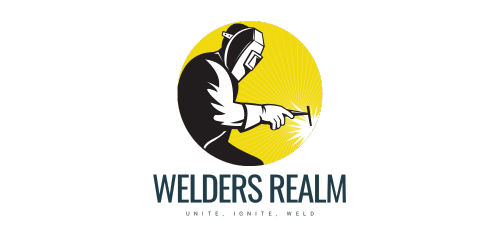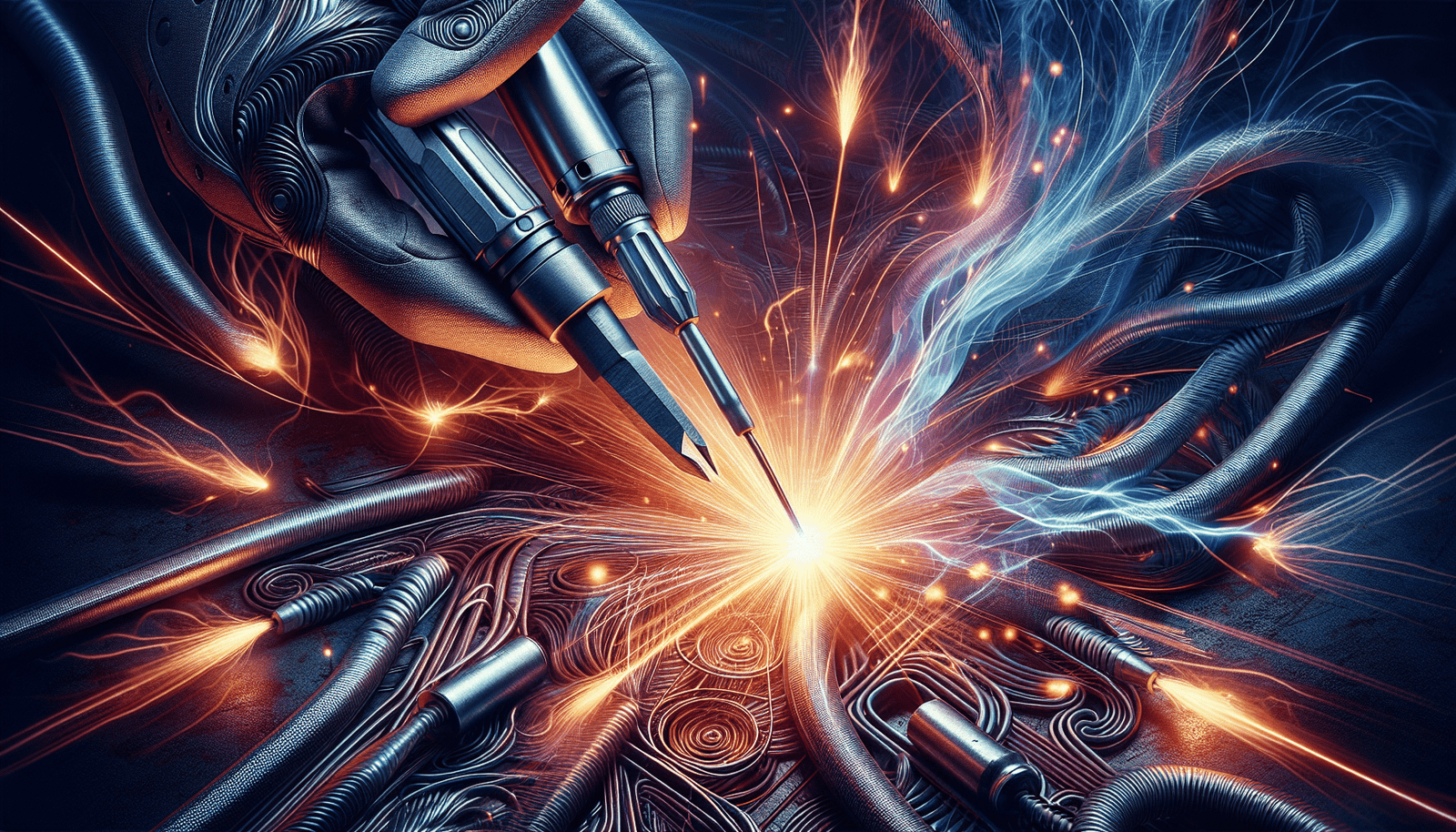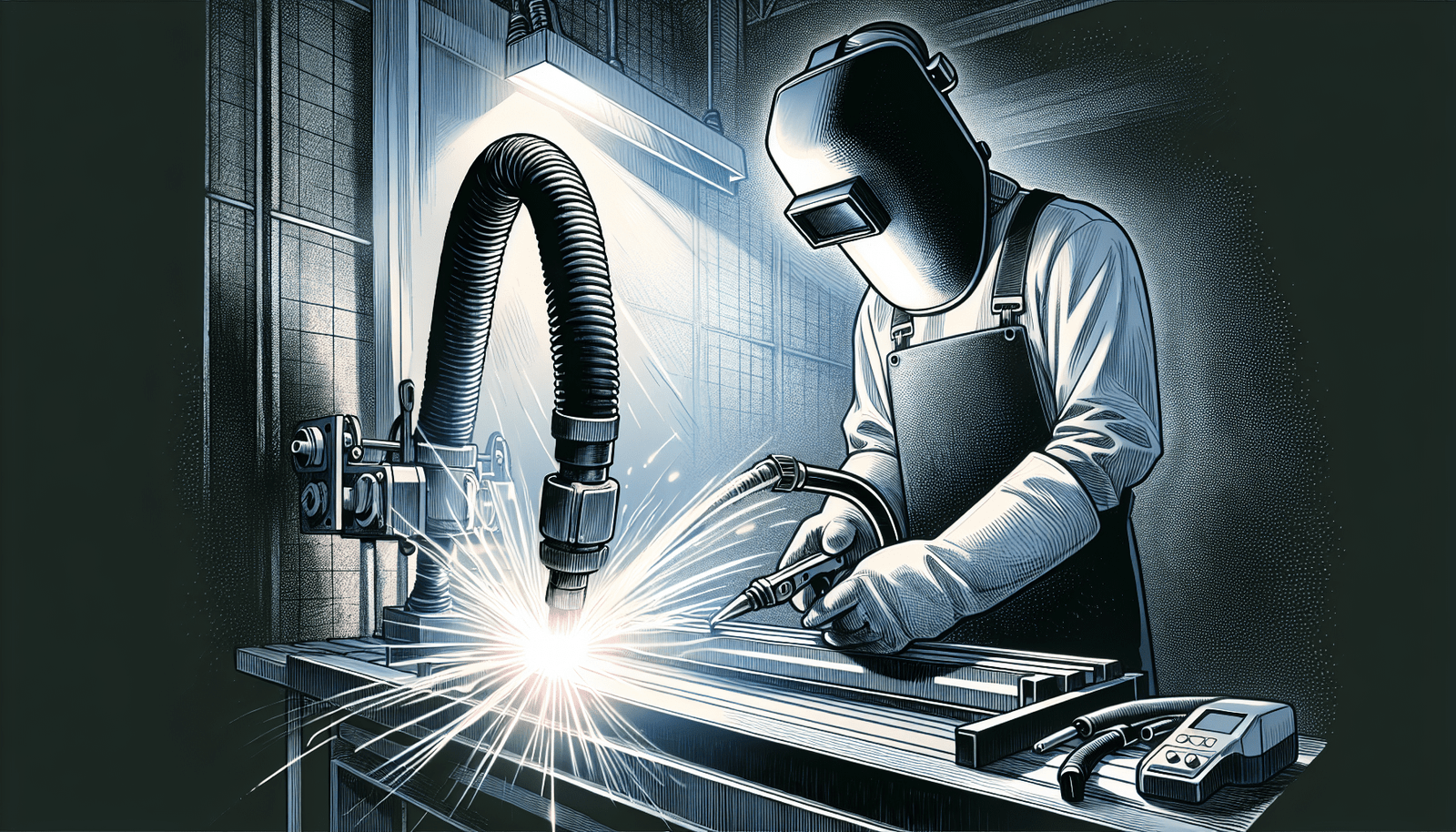Have you ever wondered what automotive welding is all about? Automotive welding is an essential process in the manufacturing, repairs, and modification of vehicles. It involves joining metal components together using high heat to create a strong bond. Whether you’re a welding enthusiast or simply curious about this field, this article aims to provide valuable information and answer some frequently asked questions. We’ll explore the basics of automotive welding, its importance in the industry, and even share some expert tips and product reviews. So, if you’re ready to dive into the world of automotive welding, let’s get started!
Definition of Automotive Welding
Meaning of automotive welding
Automotive welding refers to the process of joining two or more metal components together using heat applied to the materials. It is a crucial technique used in the automotive industry for various purposes, such as repairing damaged parts, fabricating new components, and ensuring structural integrity in the construction of vehicles. The skillful application of heat and the use of appropriate welding techniques are essential to create strong and durable bonds between metal surfaces.
Components involved in automotive welding
Automotive welding involves several key components that are integral to the welding process. These include the welding machine, welding electrodes or filler material, shielding gases, safety gear, and various tools for preparation and finishing. The welding machine provides the necessary electrical power to create an electric arc, which generates the heat required for welding. Welding electrodes and filler material serve as a medium to join the metal surfaces together. Shielding gases, such as argon or carbon dioxide, protect the molten metal from atmospheric contamination during the welding process. Safety gear, including helmets, gloves, and protective clothing, is essential to protect welders from potential hazards. Tools for preparation and finishing, such as grinders and wire brushes, are used to clean and prepare the metal surfaces before welding and to ensure a smooth and polished finish after welding.
Contexts in which automotive welding is used
Automotive welding finds application in various contexts within the automotive industry. It is utilized in the repair and maintenance of vehicles, enabling the restoration of damaged components and ensuring the safe operation of vehicles on the road. Additionally, automotive welding plays a crucial role in the fabrication of custom vehicles or automotive modifications by allowing the integration of new components and structures. Furthermore, automotive welding is essential in the manufacturing process of vehicles, ensuring the assembly of different metal parts to create a cohesive and structurally sound final product. Overall, automotive welding is a versatile and indispensable technique that contributes to the durability, safety, and functionality of vehicles.
Types of Automotive Welding
MIG (Metal Inert Gas) welding
MIG welding is one of the most commonly used welding techniques in the automotive industry. It involves the use of a welding machine that continuously feeds a consumable electrode wire and an inert gas, typically argon or a mixture of argon and carbon dioxide, through a welding gun. The electric arc created between the wire and the workpiece melts the wire, which acts as a filler material, and fuses the metal surfaces together. MIG welding is known for its ease of use, high welding speed, and versatility, making it suitable for various automotive welding applications.
TIG (Tungsten Inert Gas) welding
TIG welding, also known as GTAW (Gas Tungsten Arc Welding), is a precise and high-quality welding technique commonly used in automotive welding. It utilizes a tungsten electrode, a non-consumable filler material, and an inert gas, such as argon or helium, to create a controlled and focused arc. The arc heats the metal surfaces to their melting points, allowing the tungsten electrode and filler material to be added separately. TIG welding is known for its ability to produce clean welds with minimal spatter, making it suitable for welding thin materials and achieving precise welds in automotive applications.
Spot welding
Spot welding is a resistance welding technique commonly used in automotive manufacturing. It involves the use of two copper electrodes that apply pressure and electric current to the metal surfaces to be welded. The resistance to the electric current generates heat, melting the metal surfaces and creating a weld nugget. Spot welding is commonly used for joining sheet metal components, such as body panels and structural parts, in automotive assembly lines. It is known for its speed, efficiency, and ability to create strong and consistent welds.
Arc welding
Arc welding, also known as stick welding or SMAW (Shielded Metal Arc Welding), is a versatile welding technique commonly used in automotive welding. It utilizes a coated electrode that melts as it generates an electric arc with the workpiece. The molten metal from the electrode acts as a filler material and forms a strong bond between the metal surfaces. Arc welding is known for its ability to weld various metals and work in outdoor or adverse conditions, making it suitable for automotive repair and maintenance applications.
Flux cored arc welding
Flux cored arc welding (FCAW) is a variation of MIG welding that uses a flux-filled electrode wire instead of a solid wire. The flux within the wire produces shielding gases and flux residues that protect the molten metal from atmospheric contamination and improve the quality of the weld. FCAW is commonly used in automotive welding due to its versatility and ability to weld thick materials and operate in windy or drafty environments.
Benefits of Automotive Welding
Strength and durability
One of the key benefits of automotive welding is the strength and durability it provides to the welded joints. Properly executed welds create bonds between metal surfaces that are often as strong as or stronger than the base materials themselves. This ensures that the welded components can withstand the demanding conditions and forces typically experienced by vehicles on the road, such as vibrations, impacts, and structural loads. Automotive welding plays a vital role in maintaining the structural integrity of vehicles and ensuring the safety of both the occupants and the surrounding environment.
Versatility
Another significant advantage of automotive welding is its versatility in accommodating various welding applications. With different welding techniques available, such as MIG, TIG, spot welding, arc welding, and flux cored arc welding, automotive welders have the flexibility to choose the most appropriate method for specific welding tasks. Whether it involves joining thin sheet metal components, fabricating custom structures, or repairing heavy-duty automotive parts, automotive welding techniques can be adapted to suit a wide range of metal types, thicknesses, and geometries.
Efficiency and speed
Automotive welding techniques can significantly improve efficiency and speed in various manufacturing and repair processes. Techniques like MIG and spot welding allow for rapid joining of metal components, leading to faster production times in automotive assembly lines. In the context of automotive repair and maintenance, efficient welding techniques help reduce downtime and minimize vehicle repair costs. The ability to weld quickly and efficiently is especially crucial in the automotive industry, where time is of the essence and productivity is essential.
Cost-effectiveness
Automotive welding can be a cost-effective solution for repairing and fabricating automotive components. Welding repairs can often salvage damaged parts that would otherwise need to be completely replaced, saving on material costs. In cases where custom components or modifications are required, welding allows for the fabrication of specific parts without having to purchase expensive pre-made alternatives. Additionally, by having the capability to perform welding tasks in-house, automotive businesses can avoid outsourcing costs and have greater control over the quality and timeline of their projects.
Automotive Welding Safety Measures
Proper use of protective gear
When engaging in automotive welding, it is crucial to prioritize safety by wearing the appropriate protective gear. This includes a welding helmet or face shield to protect the eyes and face from harmful ultraviolet (UV) radiation, sparks, and debris. Welding gloves made of flame-resistant materials provide protection for the hands against hot metal and potential burns. In addition, welding jackets or flame-resistant clothing can protect the torso and arms from sparks and excessive heat. It is essential to choose safety gear that meets the relevant industry standards and regulations to ensure adequate protection.
Safe handling and storage of tools and materials
Proper handling and storage of welding tools and materials are essential for maintaining a safe work environment. Welding electrodes, filler wires, and other consumables should be stored in a designated area free from moisture and contaminants. This helps prevent their deterioration and ensures consistent welding performance. Sharp tools, such as wire cutters or chipping hammers, should be handled carefully to avoid injuries. It is important to keep the work area clean and organized, with tools and equipment properly stored when not in use, reducing the risk of accidents and mishaps.
The importance of a well-ventilated workspace
Maintaining adequate ventilation in the welding workspace is crucial to ensure the health and safety of the welder. Welding processes release hazardous fumes and gases, such as ozone, nitrogen dioxide, and metal fumes, which can be harmful when inhaled. It is vital to work in a well-ventilated area or use ventilation systems, such as fans or exhaust hoods, to remove contaminants and maintain air quality. If welding in a confined space is necessary, additional precautions, such as personal air purifying respirators, may be required to protect against inhalation of harmful substances.
Prerequisite Skills for Automotive Welding
Basic knowledge and understanding of welding principles
Before diving into automotive welding, it is essential to have a basic understanding of welding principles and techniques. Familiarity with different welding processes, such as MIG, TIG, and arc welding, will help in choosing the most suitable technique for specific automotive applications. Understanding welding parameters, such as welding current, voltage, and travel speed, is crucial for achieving quality welds. Additionally, knowledge of metallurgy and the properties of different metals will aid in selecting appropriate filler materials and ensuring proper heat control during welding.
Physical skills such as hand-eye coordination and dexterity
Automotive welding requires physical skills, particularly hand-eye coordination and dexterity, to manipulate welding equipment and create precise welds. The ability to control the position and movement of the welding torch or electrode while simultaneously feeding filler materials demands coordinated hand-eye movements. Fine motor skills and dexterity are essential when operating welding machines, adjusting welding parameters, and maneuvering in challenging welding positions. Regular practice and honing of these physical skills are crucial for achieving consistent and high-quality welds in automotive applications.
Safety awareness and adherence
Safety awareness is a fundamental prerequisite for anyone involved in automotive welding. Understanding and adhering to safety guidelines and protocols ensure the well-being of both the welder and others in the vicinity. This includes knowledge of proper welding techniques, safe handling of equipment, and identification of potential hazards. Being aware of the risks associated with welding, such as electric shock, burns, and exposure to harmful fumes, allows for the implementation of appropriate safety measures. Constant vigilance and a commitment to safety practices are essential for a successful and safe automotive welding experience.
Training and Certification in Automotive Welding
Training programs and courses
Obtaining formal training in automotive welding can significantly enhance one’s skills and employability in the automotive industry. Many vocational and technical schools, as well as community colleges, offer welding programs that focus on automotive applications. These programs typically cover welding theory, hands-on practical training, and safety procedures specific to automotive welding. By enrolling in such training programs, individuals can gain a comprehensive understanding of automotive welding techniques and develop the necessary skills to excel in this field.
Certification processes and institutions
Certification in automotive welding is often required or preferred by employers to ensure the competence of welders. Various organizations, such as the American Welding Society (AWS) and the International Institute of Welding (IIW), offer certifications that validate the skills and knowledge of welders. These certifications typically involve written examinations, practical welding tests, and adherence to specific welding codes and standards. Achieving certification demonstrates a welder’s commitment to their craft and their ability to meet industry standards, making them more marketable and increasing their career prospects in the automotive welding field.
Career prospects with certification
Obtaining certification in automotive welding can open doors to a wide range of career opportunities in the automotive industry. Certified welders are sought after by automotive manufacturers, repair shops, and custom automotive fabrication businesses. With the automotive industry constantly evolving and the demand for skilled welders continuing to grow, certified automotive welders can secure stable employment and potentially advance to supervisory or specialized positions. Certification not only enhances one’s technical skills but also provides credibility and recognition within the industry, making it easier to pursue a long and successful career in automotive welding.
Common Challenges in Automotive Welding
Dealing with different types of metals
Automotive welding often involves working with a variety of metals, each with its unique characteristics and welding requirements. Challenges arise when welding dissimilar metals, such as steel and aluminum, which have different melting points and thermal conductivity. Welding different metals may require adjusting welding parameters, using specialized filler materials, or employing specific welding techniques to achieve proper fusion and prevent defects. Furthermore, the presence of coatings or corrosion on metal surfaces can affect the welding process, requiring proper cleaning and preparation techniques. Overcoming these challenges requires a thorough understanding of metallurgy and the ability to adapt welding techniques to suit specific metal combinations.
Mitigating welding distortions
Welding can introduce distortion and warping in metal components, especially in thin materials or complex structures. The uneven heating and cooling during the welding process cause changes in the shape and dimensions of the welded parts. To mitigate welding distortions, various techniques, such as preheating the metal, using clamping devices or fixtures, and performing a sequence of welds, can be employed. Proper planning and execution of welding sequences, along with careful consideration of material thicknesses and heat control, are crucial to minimize distortions and ensure the desired fit and finish of welded automotive components.
Preventing rust and corrosion
One of the challenges in automotive welding is preventing or minimizing rust and corrosion in welded joints. The heat generated during welding can alter the metallurgical structure of the base metal, making it susceptible to oxidation and corrosion. To mitigate this, it is important to choose appropriate welding processes and filler materials that minimize the introduction of impurities and maintain the integrity of the metal. Additionally, applying corrosion-resistant coatings or implementing post-weld treatments, such as passivation or painting, can effectively protect the welded joints from environmental factors that may lead to rust and corrosion. Proper preventive measures and proactive maintenance play a vital role in ensuring the longevity and performance of automotive welds.
Automotive Welding Equipment
Explanation of different welding machines
Automotive welding equipment includes various welding machines that generate heat and electrical current for the welding process. MIG welding machines, also known as wire feeders or welders, are commonly used in automotive applications. These machines consist of a power source, a wire feeder, and a welding gun. TIG welding machines, on the other hand, employ a power source and a welding torch with controls for current and gas flow. Arc welding machines, including stick welders or SMAW machines, utilize a power source and welding cables with electrode holders. Flux cored arc welding machines are similar to MIG welders, but they have specific settings for flux cored wire and gas flow. The choice of welding machine depends on the specific welding technique and the requirements of the automotive welding project at hand.
Safety gear and accessories
Safety gear and accessories are essential components of automotive welding equipment. A welding helmet or face shield is crucial to protect the eyes and face from intense light, sparks, and debris generated during welding. Welding gloves made of flame-resistant materials protect the hands from heat and potential burns. Welding jackets or flame-resistant clothing shield the body from sparks and excessive heat. Ear protection, such as earplugs or earmuffs, helps prevent hearing damage from the noise generated during welding. Additionally, safety glasses, welding curtains or screens, and fire extinguishers are essential accessories that contribute to a safe welding environment.
Other essential tools for automotive welding
In addition to welding machines and safety gear, several other tools are essential for automotive welding. These include wire cutters or pliers for cutting and shaping welding electrodes or filler wires, a chipping hammer or wire brush for cleaning and preparing metal surfaces before welding, and clamps or fixtures for holding components in position during the welding process. Other tools, such as grinders or sanders, may be required for post-welding cleaning, surface preparation, or weld finishing. The availability and proper use of these tools contribute to the efficiency and quality of automotive welding projects.
Automotive Welding Procedures
Preparation of metal surfaces
Proper preparation of metal surfaces is crucial for successful automotive welding. Before welding, it is important to clean the metal surfaces to be welded thoroughly. This involves removing any paint, rust, dirt, oil, or contaminants that may affect the quality of the weld. Cleaning methods can include using wire brushes, grinders, or chemical solutions specifically designed for surface preparation. After cleaning, the metal surfaces may need to be properly shaped or beveled to achieve satisfactory weld penetration and fusion. The preparation of metal surfaces ensures optimal conditions for welding and helps produce strong and durable welds in automotive applications.
Techniques for different types of welds
Automotive welding involves various types of welds, each requiring specific techniques for successful execution. Butt welds, where two metal edges are joined together, are commonly used in automotive applications to create strong and continuous connections. Other types of welds include fillet welds, where the weld is made along the intersection of two metal surfaces, and lap welds, where one metal surface overlaps another. Each weld type requires specific joint preparation, welding parameters, and techniques, such as weaving or stitch welding, to ensure proper fusion and strength. Understanding and practicing these welding techniques are essential for achieving high-quality welds in automotive welding projects.
Post-welding practices
Post-welding practices are crucial to ensure the quality and integrity of automotive welds. This includes removing any welding slag, spatter, or excess filler material that may be present on the weld surface. This can be accomplished by using chipping hammers, wire brushes, or grinders while taking care not to damage the base metal. Afterward, further cleaning and finishing may be required to remove any remaining welding residues and achieve a smooth and polished appearance. This can involve additional grinding or sanding, as well as applying protective coatings or paints to prevent corrosion. Proper post-welding practices help enhance the overall appearance, longevity, and performance of automotive welds.
Future of Automotive Welding
Advancements in welding technology
The future of automotive welding holds exciting possibilities with advancements in welding technology. Emerging technologies, such as laser welding and friction stir welding, offer new opportunities to improve the efficiency, precision, and quality of automotive welds. Laser welding, for instance, utilizes a focused high-intensity laser beam to generate heat and create welds with minimal distortion and heat-affected zones. Friction stir welding, on the other hand, relies on frictional heat generated by a rotating tool to join materials without melting them, resulting in superior weld strength and reduced defects. These innovative welding techniques have the potential to revolutionize automotive welding, enabling faster production times, lightweight vehicle designs, and enhanced overall performance.
Evolving safety and efficiency standards
As the automotive industry continues to prioritize safety and efficiency, the standards and regulations surrounding automotive welding are expected to evolve. There will likely be a greater emphasis on safety measures, such as improved ventilation systems, enhanced protective gear, and stricter adherence to welding codes and standards. Efforts to minimize welding distortions and improve welding quality will drive the development of advanced welding processes, better training programs, and more comprehensive certification requirements. Additionally, the integration of automation and robotics in automotive welding is expected to increase, leading to improved productivity, precision, and consistency in welding operations.
Influence of electric and autonomous vehicles on automotive welding
The rise of electric and autonomous vehicles is expected to influence the field of automotive welding significantly. As electric vehicles become more prevalent, welding techniques specific to the joining of dissimilar metals, such as steel and aluminum, will gain importance due to the differing properties of these materials in electric vehicle construction. Additionally, the lightweight design of electric and autonomous vehicles may require the exploration of new materials and welding techniques that optimize strength and durability while reducing overall vehicle weight. The integration of sensors, cameras, and other advanced technologies in autonomous vehicles may present challenges and opportunities for automotive welders, requiring specialized knowledge and skills in welding electronic components and denser vehicle wiring systems.
In conclusion, automotive welding plays a critical role in the automotive industry by enabling the repair, fabrication, and assembly of vehicles. With various welding techniques available, such as MIG, TIG, spot welding, arc welding, and flux cored arc welding, automotive welders have the flexibility to choose the most suitable method for specific automotive applications. Automotive welding provides numerous benefits, including strength, durability, versatility, efficiency, and cost-effectiveness. However, it is essential to prioritize safety by wearing appropriate protective gear, practicing safe handling and storage of tools and materials, and working in a well-ventilated workspace. Prerequisite skills for automotive welding include a basic knowledge of welding principles, physical skills such as hand-eye coordination and dexterity, and safety awareness and adherence. Training and certification programs can further enhance skills and provide better career prospects in the automotive welding field. Challenges in automotive welding include dealing with different types of metals, mitigating welding distortions, and preventing rust and corrosion. Automotive welding equipment, such as welding machines, safety gear, and essential tools, are integral to the welding process. Preparing metal surfaces, employing proper welding techniques, and practicing post-welding procedures contribute to successful automotive welds. The future of automotive welding holds advancements in welding technology, evolving safety and efficiency standards, and the influence of electric and autonomous vehicles on welding practices. With continuous innovation and adaptation, automotive welding will continue to play a crucial role in the development and production of safe, reliable, and technologically advanced vehicles.




